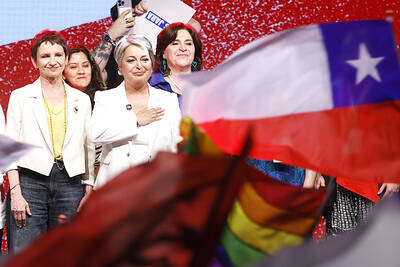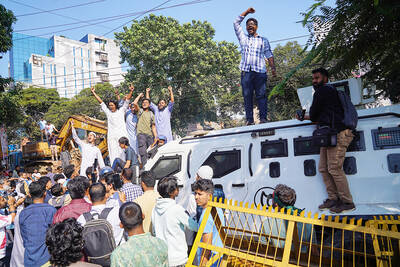Faced with the imminent release of a report by international nuclear inspectors, Iran acknowledged publicly on Sunday that it secretly purchased components for its nuclear program from a network of international suppliers, but continued to insist that its program was for electricity production, not nuclear weapons.
The statement, by the Foreign Ministry, came after the head of the Supreme National Security Council, Hassan Rohani, met in Vienna with the director-general of the International Atomic Energy Commission (IAEA), Mohamed ElBaradei.
European and US diplomats say they believe that ElBaradei summarized the results of a report the IAEA is expected to release this week about Iran's nuclear program, including details that Iran withheld last fall when, under pressure from Europe and the US, it revealed 18 years of nuclear activity.
"The Iranians are admitting to the dimensions of their program bit by bit as they are confronted with individual pieces of evidence," said one senior US official involved in the investigations of the nuclear trading network set up by Abdul Qadeer Khan, the father of the Pakistani weapon.
"Compare it to what the Libyans are doing. I'm convinced the Libyans are voluntarily showing us everything," the official said, referring to Libya's decision to dismantle all of its nuclear weapons program.
The official added: "The Iranians are still stonewalling."
Reuters reported on Sunday that the spokesman for Iran's Foreign Ministry, Hamid Reza Asefi, said that "we have bought some things from some dealers but we don't know what the source was or what country they came from."
He insisted that every purchase had been reported to the IAEA.
Iran's statements are significant because few US or European officials say they understand how far the country's nuclear program has advanced, or how close the country may be to producing a nuclear weapon. Because Khan's network sold Libya equipment, full warhead designs and the raw uranium gas that must be enriched to produce bomb fuel, US officials say they assume that Iran received the same package of goods.
On Friday, the Malaysian police released a report of its interrogations of B.S.A. Tahir, whom US President George W. Bush has identified as Khan's chief lieutenant. In the report, the police quoted Tahir as saying that Iran paid about US$3 million for parts to manufacture centrifuges, which turn the uranium into highly enriched weapons-grade fuel. The parts arrived in Iran in 1994 or 1995, officials said, about seven years after the first transactions between Iran and Pakistan. That shipment was something of a surprise to US officials, who until recently only had evidence of Pakistani shipments to Iran in the 1980s.
It now appears that the later shipments were part of an effort to sell Iran a more sophisticated type of centrifuge, called a "P-2," which enriches uranium more efficiently than the first models sold to Tehran. The Iranians say they informed the IAEA last fall that they had worked experimentally with the P-2 design, but some agency officials say the information was only passed along after it became clear that Khan was being interrogated.

DISASTER: The Bangladesh Meteorological Department recorded a magnitude 5.7 and tremors reached as far as Kolkata, India, more than 300km away from the epicenter A powerful earthquake struck Bangladesh yesterday outside the crowded capital, Dhaka, killing at least five people and injuring about a hundred, the government said. The magnitude 5.5 quake struck at 10:38am near Narsingdi, Bangladesh, about 33km from Dhaka, the US Geological Survey (USGS) said. The earthquake sparked fear and chaos with many in the Muslim-majority nation of 170 million people at home on their day off. AFP reporters in Dhaka said they saw people weeping in the streets while others appeared shocked. Bangladesh Interim Leader Muhammad Yunus expressed his “deep shock and sorrow over the news of casualties in various districts.” At least five people,

LEFT AND RIGHT: Battling anti-incumbent, anticommunist sentiment, Jeanette Jara had a precarious lead over far-right Jose Antonio Kast as they look to the Dec. 14 run Leftist candidate Jeannette Jara and far-right leader Jose Antonio Kast are to go head-to-head in Chile’s presidential runoff after topping Sunday’s first round of voting in an election dominated by fears of violent crime. With 99 percent of the results counted, Jara, a 51-year-old communist running on behalf of an eight-party coalition, won 26.85 percent, compared with 23.93 percent for Kast, the Servel electoral service said. The election was dominated by deep concern over a surge in murders, kidnappings and extortion widely blamed on foreign crime gangs. Kast, 59, has vowed to build walls, fences and trenches along Chile’s border with Bolivia to

DEATH SENTENCE: The ousted leader said she was willing to attend a fresh trial outside Bangladesh where the ruling would not be a ‘foregone conclusion’ Bangladesh’s fugitive former prime minister Sheikh Hasina yesterday called the guilty verdict and death sentence in her crimes against humanity trial “biased and politically motivated.” Hasina, 78, defied court orders that she return from India to attend her trial about whether she ordered a deadly crackdown against the student-led uprising that ousted her. She was found guilty and sentenced to death earlier yesterday. “The verdicts announced against me have been made by a rigged tribunal established and presided over by an unelected government with no democratic mandate,” Hasina said in a statement issued from hiding in India. “They are biased and politically motivated,” she

It is one of the world’s most famous unsolved codes whose answer could sell for a fortune — but two US friends say they have already found the secret hidden by Kryptos. The S-shaped copper sculpture has baffled cryptography enthusiasts since its 1990 installation on the grounds of the CIA headquarters in Virginia, with three of its four messages deciphered so far. Yet K4, the final passage, has kept codebreakers scratching their heads. Sculptor Jim Sanborn, 80, has been so overwhelmed by guesses that he started charging US$50 for each response. Sanborn in August announced he would auction the 97-character solution to K4